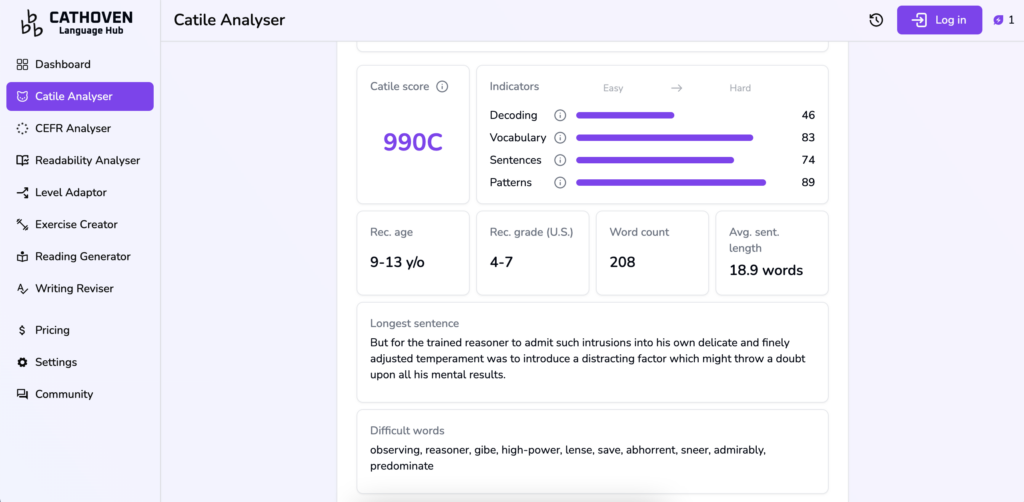You’ve read our article about Lexile and now you want to know how to use lexile scores. Good news: there are several ways to use this popular framework for your or your student’s benefit, including the ability to assess educational materials and your student’s reading ability.
Lexile Levels
Before doing anything, you need to know your student’s Lexile level to check their reading range. But before they run off and take a Lexile test, let’s check the possible levels you can get. The chart below is for someone with a proficient reading ability, meaning they read at their grade level, not below or at an advanced level.
Grade |
Level |
|---|---|
|
1 |
100L-400L |
|
2 |
300L-600L |
|
3 |
500L-800L |
|
4 |
600L-900L |
|
5 |
700L-1000L |
|
6 |
800L-1050L |
|
7 |
850L-1100L |
|
8 |
900L-1150L |
|
9 |
1000L-1200L |
|
10 |
1025L-1225L |
|
11 |
1050L-1300L |
More detailed charts can be found on Lexile’s website, but now let’s look at what you can do with your all-important Lexile score. Ready?
Match Texts to Readers
What fun is a book if it’s too easy or too difficult for you to read? If your student’s Lexile score is 600L and you give them a text of 1050L, way outside their Lexile range, they are going to find the experience overwhelming. Who wants to be bogged down by difficult concepts and complex words that force you to pull out a dictionary every second sentence? Occasionally is fine, possibly beneficial, but the reading experience shouldn’t look like someone deciphering a foreign language or code.
Too easy isn’t good either. We all love The Very Hungry Catapillar, but students in higher grades are unlikely to find it a stimulating subject to write essays on. Pick your reading material carefully. The difficulty should be such that it inspires growth and is level appropriate.
Encourage Independent Reading
Many children dislike the reading set for them at school and carry the misbelief that they don’t like books into adulthood. If they are lucky enough, they might latch onto a novel or blog and experience a breakthrough in young adulthood: “Wow, I do like reading!” Some are not so lucky.
How do we, as educators, prevent this? Remember, children are curious creatures. Once we have their Lexile level, we can provide them with a wide range of appropriate reading material for them to develop their own tastes. We can foster their love of reading, support their literacy development and even encourage independent reading outside of the classroom. Imagine that!
When Possible, tailor reading to the needs of your students.
Don't Forget Context and Comprehension
Speaking of tailoring texts and independent reading, remember that Lexile scores only measure text complexity. They don’t factor a student’s background knowledge, religious beliefs, culture or personal interests. If you are setting reading for a particular student, or giving extra help to a student struggling with these aspects, you should keep these details in mind. Knowing how to use Lexile scores is only the beginning. Use your knowledge of their reading level and your wisdom as a teacher to help.
Choose Appropriate Instructional Material
Nothing is worse than instructions you don’t understand. Imagine you’re the world’s best racing driver, but you can’t get your engine going at the starting line. Meanwhile, the other drivers are already roaring ahead, leaving you in their dust. You’d feel pretty put out by the poor instructions you got before the race. If you could just get this finely tuned engine to purr, you’d be hot on their heels. If you’d pardon the anology, this is the injustice many students feel because of poor teaching instructions.
Monitoring Progress
Of course, one of the greatest aspects of using Lexile scores is the ability to precisely measure and monitor a student’s reading progress. You set appropriate reading for them throughout the year and watch their Lexile score grow with each test. This score tells you when they are ready for the next book or article, one that’s a bit more challenging than the last.
Or, maybe you need to know if your student is ready to take a reading or literature exam. If you teach English as a foreign language, you might want to know the Lexile score and reading range of your student to see how they would assimilate into the US school system, for example, where they might wish to study and where Lexile levels are often used.
Use Lexile Tool and Online Databases
Free Lexile Alternatives
Lexile is a fantastic framework, but there are equally fantastic alternatives on the market that have similar or different purposes entirely.
If you teach English as a foreign language, you might be interested in the ACTFL, CEFR and Cambridge scales. Another alternative to the Lexile system is the Fountas & Pinnell reading level system, including their Levelled Literacy Interventions (LLI). For general reability tools, there’s the Gunning Fog Index and the Flesch-Kincaid Level system.

Cathoven has its very own Lexile alternative, Catile. This advanced, AI-powered, revolutionary tool for native speakers uses the latest technology for even more comprehensive output. It measures and decodes difficulty by analysing pronunciation, vocabulary, sentences, and other patterns found in texts–and more.
And unlike Lexile, it’s free to use.
So why not take Catile for a quick duet?
